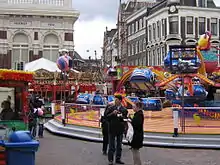Octopus (ride)
The Octopus is a type of amusement ride in the shape of an octopus. Five to eight arms attached to a central axis spin and move up and down in random, while cars at the end of the arms, either attached directly to the arm or fixed on spinning crosses, spin freely or stay in place, depending on the exactly type of ride. Each Octopus ride has the arms attached the middle of the ride. The middle of the ride or centric will move somehow (Octopus head, Spider cylinder object, and so on). Most octopus rides require guests to be at least 42 inches to ride without an adult; smaller children must have an adult with them. This is a regular of the annual AGS and AHS fairs in Ateneo de Manila University


Different Types of Octopus

There are many different kinds of Octopus. They include:
- Eyerly Octopus — One of the oldest of the Octopus rides, this variant, built by the Eyerly Aircraft Company of Oregon, has eight arms, with one car attached to each arm. As the arms move up and down, the cars can spin freely. The arms, much like the other Eyerly designs, stay in a fixed position, and can not be lowered. This means that the ride must be loaded car by car by the operator, rather than all at once.
- Eyerly Spider — This ride is similar to the Octopus, only rather than having eight arms with one car each, there are only six arms but with two cars each.
- Eyerly Monster — Easily the fanciest of the Eyerly designs, this ride, much like the spider, has six arms. But rather than two cars, it has four cars attached to a spinning cross.
- Klaus (SDC) Polyp — Originally built in the 1960s by Klaus of Germany, this ride has five arms, with 4 cars attached to a spinning cross at the end of each arm. This makes this variation of the Octopus ride is similar to the Eyerly Monster design, but differs in two key ways; The cars do not spin as they are attached to the side of the cross arm, and the main arms have the ability to be lowered up and down, rather than staying in a fixed position. This makes the loading and unloading of the ride much quicker and easier. Although the Klaus machines are not extremely common, this design became very popular in Western Europe, with the most common builders of these attractions being Bakker and CAH, both of the Netherlands.
- Schwarzkopf Monster — This popular variant built by Schwarzkopf of Germany is similar to the Klaus Polyp, however, much like Eyerly Monster, the cars are allowed to spin freely on the cross, rather than being attached to the side. The ride has five arms, with either four or five cars attached to each arm. There have been three different models of Monster built by Schwarzkopf (with the most popular being the Monster III), but they all function the same. Sartori of Italy also makes a similar ride.
- Looping/ Suspended Polyp — Originally designed by Wieland Schwarzkopf (son of Anton Schwarzkopf), the Looping Polyp was similar to the Monster, but featured cars that could flip over as well as spin (similar to a Mondial Shake ride). The cars were also suspended below the crosses, rather than above. The prototype, Sound Factory, built for German showman Kinzler in 1997, was the only Looping Polyp ever built, as the ride was plagued by mechanical issues and was pulled out of service just a couple years later.[1] Around the 2008/2009 season, Gerstlauer of Germany replaced the original looping cars with spinning cars for showman Aigner, who currently travels the ride around to various German Funfairs under the name Parkour.[1] As of March 2017, Gerstlauer still offers the Suspended Polyp.
Ride locations
- Octopus (Eylerly Octopus) - Hydro Free Fair- Hydro, Oklahoma
- Monster (Eyerly Monster) – Cedar Point
- Monster (Eyerly Monster) – Kings Island (1972–present)
- Monster (Eyerly Monster) – Valleyfair
- Monstruo (Schwarzkopf Monster III) – Parque de la Ciudad (1983–present), Buenos Aires, Argentina
- Octopus (Vortex) – Riverside County Fair and National Date Festival
- Sea Warrior (Klaus [SDC] Polyp) – Indiana Beach (formerly at Kiddieland and Lake Winnie)
- Spider (Eyerly Spider) – Bill Hames Amusements, carnival
- Spider (Eyerly Spider) – Lakeside Amusement Park
- Spider (Eyerly Spider) – Elitch Gardens
- Spider (Eyerly Spider) – NAME (All Star Amusements)
- Spider (Eyerly Spider) – Oaks Amusement Park
- Spider (Eyerly Spider) – Tom Evans United Shows
- Spider (Eyerly Spider) Evans Midland Empire Shows, Inc.
- Spider (Eyerly Spider) – Idlewild Park
- Spider (Eyerly Spider) – Luna Park, Melbourne
- Spider (Eyerly Spider) - Camden Park
- Octopus (Eyerly Octopus) - ; Great American Shows.
- Spider (Eyerly Spider) - Waldameer Park
- El pulpo (Eyerly Spider) – Parque Nacional de Diversiones Costa Rica
- Spider (Eyerly Spider) River City Carnival
- Spider (Eyerly Spider) - South Florida Fair
- The Lobster (Schwarzkopf Monster III) – Six Flags Great America
- Spider (Eyerly Spider) - Conneaut Lake Park
See also
References
- "Schwarzkopf Coaster Net". schwarzkopf-coaster.net. Retrieved 2017-03-31.
External Videos
Manufacturer Site
- Sartori Rides
- Emiliana Luna Park srl (ITALY)